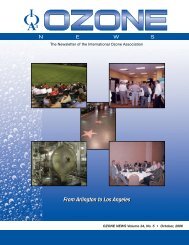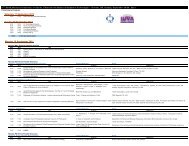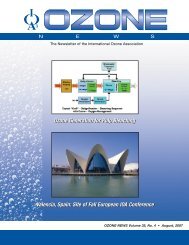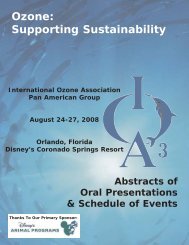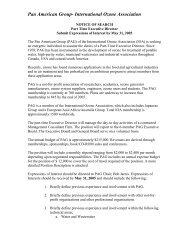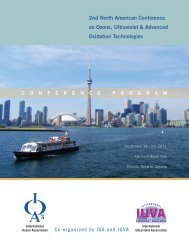Vol 33 No 4 Text - International Ozone Association
Vol 33 No 4 Text - International Ozone Association
Vol 33 No 4 Text - International Ozone Association
Create successful ePaper yourself
Turn your PDF publications into a flip-book with our unique Google optimized e-Paper software.
<strong>Ozone</strong> News <strong>Vol</strong>ume <strong>33</strong>, <strong>No</strong>. 4<br />
Effect of dissolved ozone on TMP<br />
The change of TMP (transmembrane pressure) with a<br />
variation of dissolved ozone on the membrane surface<br />
is shown in Figure 3. It is evident that the behavior of<br />
TMP is influenced by dissolved ozone concentration.<br />
That is, keeping the dissolved ozone concentration on<br />
the membrane surface at 1.0mg/L can prevent the rise<br />
of TMP. Therefore, this reveals that the dissolved<br />
ozone may decompose or modify organic materials on<br />
the membrane surface and reduce fouling of<br />
membrane. The dissolved ozone concentration of<br />
1.0mg/L is necessary to keep the stable operation of<br />
MF membrane system.<br />
Page 24<br />
The change of TMP during the continuous filtration test<br />
is shown in Figure 4. The dissolved ozone concentration<br />
on the membrane surface was controlled approximately<br />
1.0 mg/L. Membrane flux was 5.0 m3/m2. d. TMP doesn’t<br />
rise rapidly and change slowly. At an elapse of 3,800<br />
hours, TMP goes to only 120kPa. This value is less than<br />
TMP of 200kPa, at which chemical cleaning is necessary.<br />
This proves that a stable membrane operation at high flux<br />
in the long term is obtained by controlling the dissolved<br />
ozone concentration of 1.0 mg/L on the membrane<br />
surface.<br />
Conclusions<br />
The reclamation system using MF membrane together<br />
with ozone could provide high filtration flux of 5 m3 /m2. d<br />
and a stable operation without chemical cleaning in the<br />
long term. The water obtained by this reclamation system<br />
was a high quality and excellent in security against<br />
pathogenic organisms.<br />
This system has following superior features:<br />
1. The reclamation water obtained has a high quality<br />
without color, odor and suspended matters.<br />
Furthermore, it is excellent in security against<br />
pathogenic organisms.<br />
2. An economical membrane filtration system can be<br />
designed based on higher filtration flux.<br />
3. This system can be installed in a limited space.<br />
Based on the above-mentioned data, the reclamation<br />
plant was constructed at Shibaura water reclamation<br />
center, bureau of sewerage of Tokyo Metropolitan<br />
Government and began to operate in April 2004. This<br />
plant has treatment capacity of 4,300 m 3/d. MF<br />
membrane units are shown in Figure 5 (page 30). The<br />
reclamation water is distributed to the redeveloped areas<br />
in Shinagawa, Shiodome and Oosaki as toilet flashing<br />
water and environmental uses. The water quality of<br />
reclamation water obtained is much better than that of<br />
existing sand filters and gets a good reputation by users.<br />
In addition, the heat island phenomenon is now at stake<br />
in highly urbanized areas. Sprinkling water on the roads<br />
gives effect of preventing temperature on the roads and in<br />
the atmosphere from going up. This reclamation water is<br />
used as a measure of the heat island phenomenon. In the<br />
future, the reclamation water with high water quality is<br />
desired to apply progressively for many kinds of reuse.




